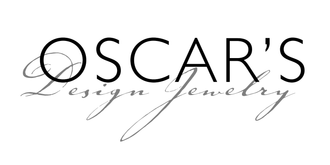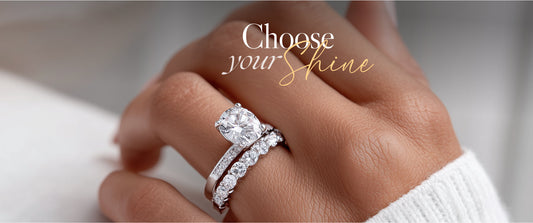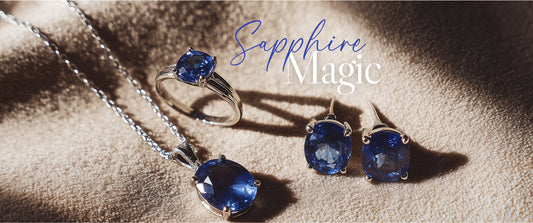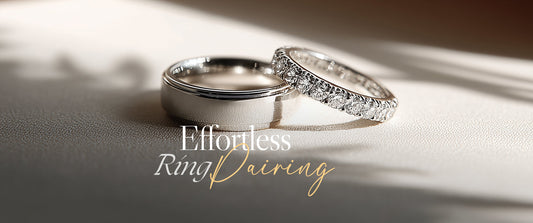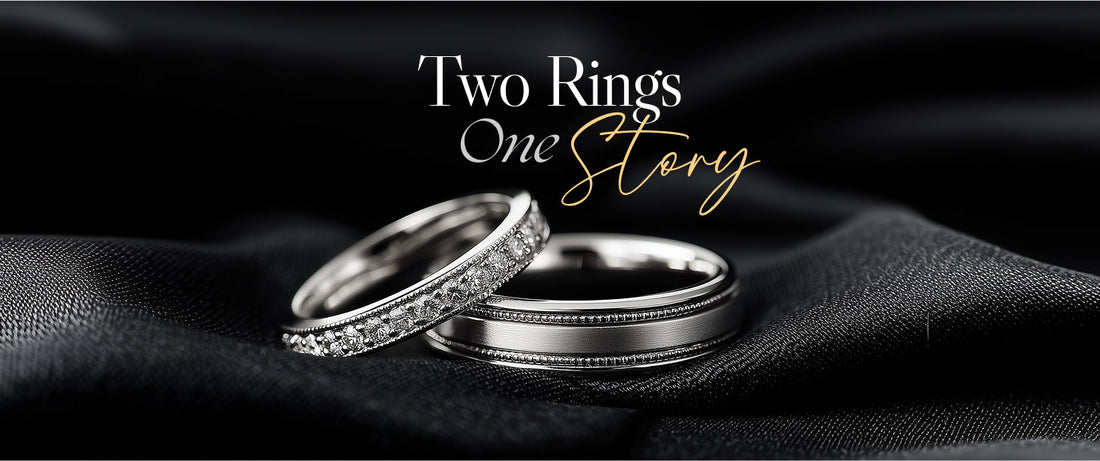
Why Some Couples Choose Matching Wedding Sets
There's something quietly powerful about matching wedding bands. Not identical — that would be impossible with different hand sizes and personal styles — but thoughtfully coordinated. When you choose rings that speak to each other, you're making a statement about your partnership that goes beyond words.
Some couples know immediately that they want matching sets, while others discover the appeal only when they start shopping together. Here's why this choice resonates with so many people and what it actually looks like in practice.
It's a visual reminder of your connection
Wedding rings are the one piece of jewelry most people wear every single day, so when yours echoes your partner's through shared metal, similar design elements, or coordinated details, you carry a small reminder of your bond wherever you go.
The connection is subtle but meaningful — a shared design language that only you two fully understand. Maybe it's the same brushed finish that catches light the same way, matching vintage-inspired milgrain details, or bands that literally nestle together when you hold hands.
These visual cues show up in unexpected moments throughout your day. When you're in a meeting and catch a glimpse of your ring, you think of them. When you see their hand on a coffee cup and notice that familiar metal, you feel that quiet sense of belonging.
You're building something together from the start
Choosing matching wedding sets is often one of the first major design decisions couples make together. Rather than just picking individual rings, you're creating a cohesive look that represents your shared taste, values, and vision for your life together.
The process itself teaches you things about each other that might surprise you. You might discover that your partner cares more about comfort than you expected, while they learn that you have surprisingly strong opinions about metal finishes. You both might realize that you want something built to age beautifully rather than follow current trends.
The conversations that happen during ring shopping often go deeper than you anticipate. You end up talking about longevity, tradition, personal style, and what you want your marriage to look and feel like. The matching rings become a tangible symbol of all those decisions you made together.
It simplifies the decision-making process
When you decide early on that you want matching sets, it actually makes the selection process less overwhelming. Instead of conducting two separate ring hunts, you're looking for one coordinated design approach that works for both of your hands and lifestyles.
You can focus on finding metals and details that complement each other rather than trying to hunt down two individually perfect rings that might not look quite right when worn together. Many couples find this approach much less stressful than starting from scratch with completely separate styles and hoping they'll work well together.
Shopping together also means you can see options on each other's hands, get immediate feedback, and make decisions as a team rather than trying to describe what you're considering over text messages.
The design options are more flexible than you think
Matching doesn't have to mean identical, and most couples end up choosing rings that coordinate beautifully rather than mirror each other exactly. Here are some popular approaches:
Same metal, different widths - Both rings might be rose gold, but perhaps a 4mm band for her and a 6mm band for him to suit different hand sizes and preferences.
Shared details, different scales - The same brushed finish or milgrain edge work, but adapted and scaled to look proportional on different sized hands.
Complementary stones - Diamonds in both rings but arranged differently, or the same type of center stone with different accent stone arrangements.
Connected designs - Bands that actually fit together like puzzle pieces or share a design element that flows from one ring to the other.
The goal is coordination and visual harmony rather than uniformity. The rings should feel like they belong to the same family while still suiting each person's individual style and practical needs.
Recent matching sets that found their people
Hammered 14K Yellow Gold Band - Men's 6mm and Hammered 14K Yellow Gold with Diamonds - Women's 4mm - Both rings featured the same organic, hand-hammered texture in warm yellow gold, but her band included three small flush-set diamonds while his remained clean and simple.
Vintage Milgrain Platinum Wedding Set - Coordinated platinum bands with intricate milgrain edging that gave them an antique feel. Her ring featured a delicate curved design that nestled perfectly with her solitaire engagement ring.
Two-Tone Wedding Bands with Rose Gold Inlay - Both chose white gold as their primary metal but incorporated rose gold inlay details. Same design concept, but scaled and proportioned appropriately for each hand.
Custom Coordinate Engraved Wedding Bands - Simple, classic bands in different widths, but both engraved on the inside with the exact coordinates of the spot where they first met.
When matching might not be right
Matching sets aren't the right choice for everyone, and that's perfectly fine. Some couples have very different personal styles that would be compromised in trying to find common ground. Others specifically want their rings to reflect their individual personalities and tastes.
If one person gravitates toward bold, statement jewelry while the other prefers minimal, understated designs, forcing a matching set might mean someone ends up settling for something they don't truly love. The most important thing is that you both feel confident and excited about whatever you choose to wear every day.
Some couples find middle ground choosing the same metal but different designs, or coordinating selecting rings from the same designer or collection even when the specific styles vary significantly.
Making it work practically
If you're considering matching sets, here are some practical considerations:
Start with the metal choice — Usually the easiest place to find common ground. Whether it's platinum, white gold, yellow gold, or rose gold, choosing the same metal creates instant visual cohesion.
Account for lifestyle differences — If one person works with their hands more, they might need a lower profile or more durable design. You can match the overall aesthetic while adapting practical details.
Think about proportions — The same design will likely need to be scaled differently for different hand sizes. A 2mm detail on a size 6 ring might need to be 3mm on a size 10 ring to maintain the same visual impact.
Plan for how they'll age — Choose details that will develop character together over time. Matching brushed finishes will develop patina at the same rate, and shared engraving styles will remain coordinated as the years pass.
See them together
The best way to know if matching wedding sets feel right for you is to try them on together and see how they look when you're holding hands, signing documents, or just going about your normal routine.
Visit our Downtown Los Angeles showroom to explore different approaches to coordination, from subtle shared details to more obvious visual connections. We can show you how the same design concept can be adapted to suit different hands and preferences.
Whether you end up choosing matching sets or individual rings that reflect your separate styles, what matters most is that they feel right to both of you. After all, these are the rings you'll be wearing every day for the rest of your lives together — they should make you both happy every single time you look at them.

